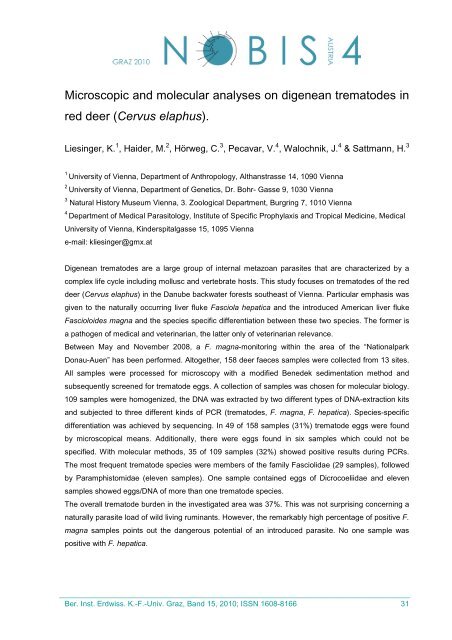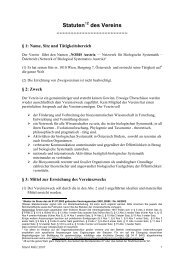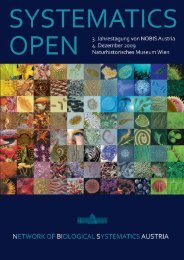4. Jahrestagung von NOBIS Austria 2. - 3. Dezember 2010
4. Jahrestagung von NOBIS Austria 2. - 3. Dezember 2010
4. Jahrestagung von NOBIS Austria 2. - 3. Dezember 2010
Create successful ePaper yourself
Turn your PDF publications into a flip-book with our unique Google optimized e-Paper software.
Microscopic and molecular analyses on digenean trematodes in<br />
red deer (Cervus elaphus).<br />
Liesinger, K. 1 , Haider, M. 2 , Hörweg, C. 3 , Pecavar, V. 4 , Walochnik, J. 4 & Sattmann, H. 3<br />
1 University of Vienna, Department of Anthropology, Althanstrasse 14, 1090 Vienna<br />
2 University of Vienna, Department of Genetics, Dr. Bohr- Gasse 9, 1030 Vienna<br />
3 Natural History Museum Vienna, <strong>3.</strong> Zoological Department, Burgring 7, 1010 Vienna<br />
4 Department of Medical Parasitology, Institute of Specific Prophylaxis and Tropical Medicine, Medical<br />
University of Vienna, Kinderspitalgasse 15, 1095 Vienna<br />
e-mail: kliesinger@gmx.at<br />
Digenean trematodes are a large group of internal metazoan parasites that are characterized by a<br />
complex life cycle including mollusc and vertebrate hosts. This study focuses on trematodes of the red<br />
deer (Cervus elaphus) in the Danube backwater forests southeast of Vienna. Particular emphasis was<br />
given to the naturally occurring liver fluke Fasciola hepatica and the introduced American liver fluke<br />
Fascioloides magna and the species specific differentiation between these two species. The former is<br />
a pathogen of medical and veterinarian, the latter only of veterinarian relevance.<br />
Between May and November 2008, a F. magna-monitoring within the area of the “Nationalpark<br />
Donau-Auen” has been performed. Altogether, 158 deer faeces samples were collected from 13 sites.<br />
All samples were processed for microscopy with a modified Benedek sedimentation method and<br />
subsequently screened for trematode eggs. A collection of samples was chosen for molecular biology.<br />
109 samples were homogenized, the DNA was extracted by two different types of DNA-extraction kits<br />
and subjected to three different kinds of PCR (trematodes, F. magna, F. hepatica). Species-specific<br />
differentiation was achieved by sequencing. In 49 of 158 samples (31%) trematode eggs were found<br />
by microscopical means. Additionally, there were eggs found in six samples which could not be<br />
specified. With molecular methods, 35 of 109 samples (32%) showed positive results during PCRs.<br />
The most frequent trematode species were members of the family Fasciolidae (29 samples), followed<br />
by Paramphistomidae (eleven samples). One sample contained eggs of Dicrocoeliidae and eleven<br />
samples showed eggs/DNA of more than one trematode species.<br />
The overall trematode burden in the investigated area was 37%. This was not surprising concerning a<br />
naturally parasite load of wild living ruminants. However, the remarkably high percentage of positive F.<br />
magna samples points out the dangerous potential of an introduced parasite. No one sample was<br />
positive with F. hepatica.<br />
_____________________________________________________________________________<br />
Ber. Inst. Erdwiss. K.-F.-Univ. Graz, Band 15, <strong>2010</strong>; ISSN 1608-8166 31






